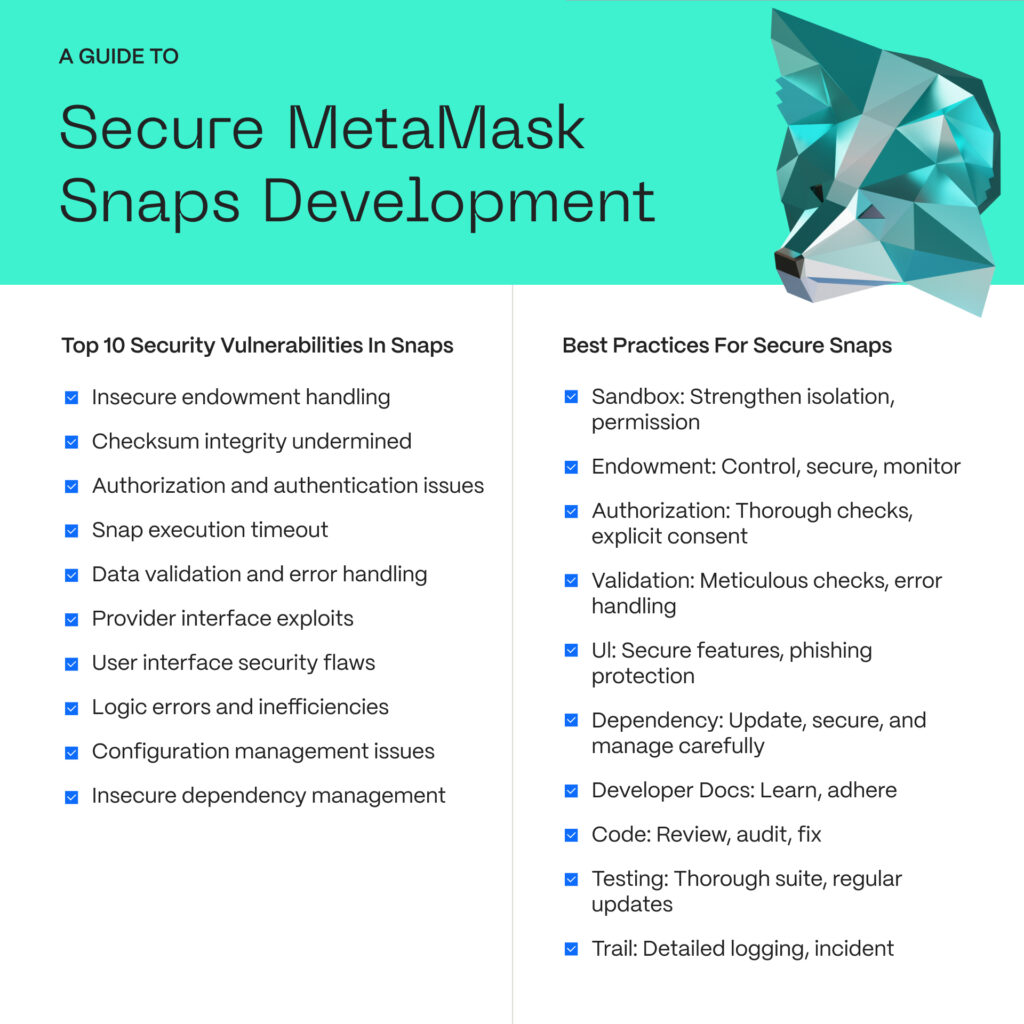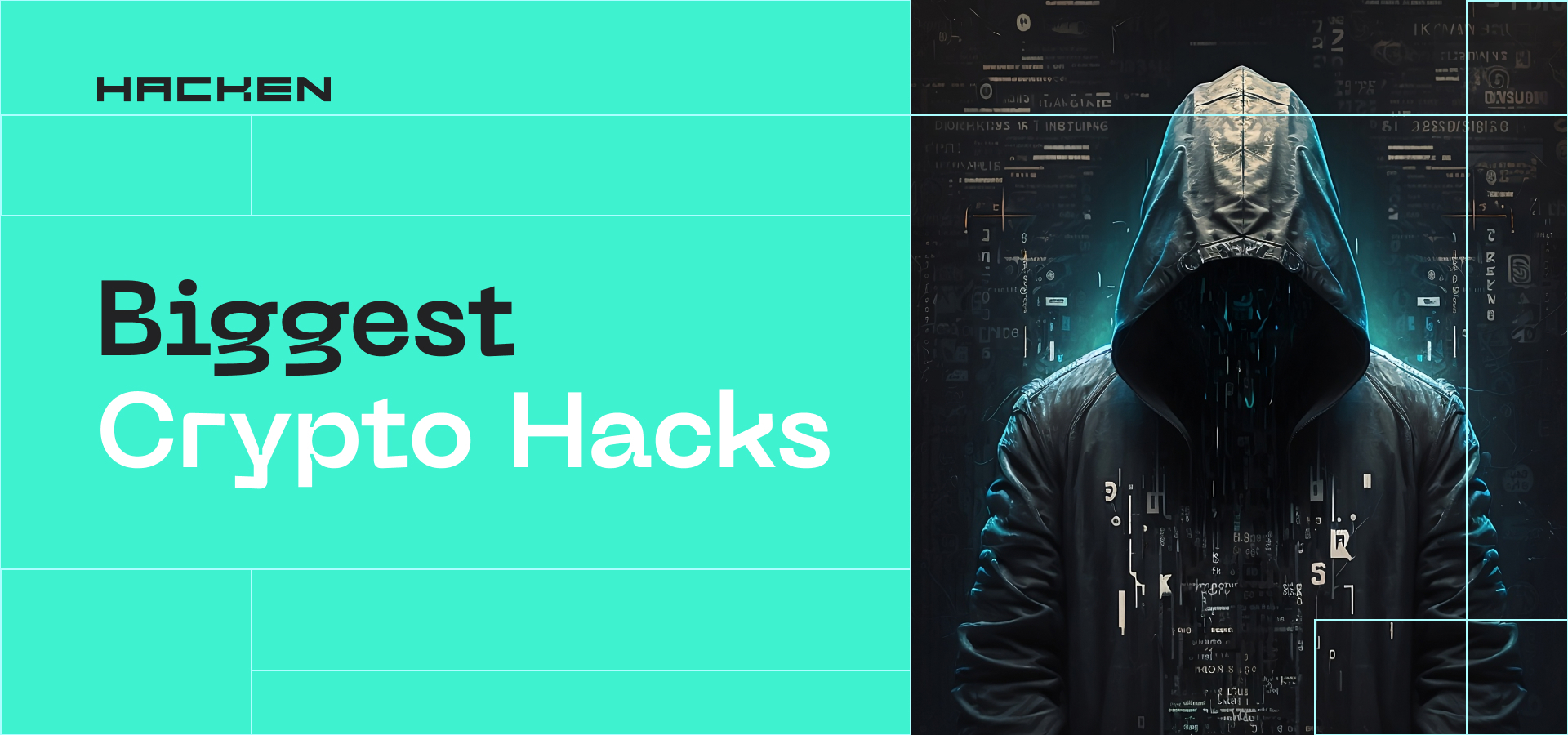The window to exchange $HAI for Hacken Equity Shares ($HES) is now open > Claim your spot today
Best Practices For Secure MetaMask Snaps Development

Introduction
MetaMask is a crypto wallet and a gateway to blockchain apps for 30 million users. With MetaMask Snaps it’s also turning into a highly customizable wallet with community-built features. Built by independent developers, these Snaps offer scalability and functionality, including interoperability, transaction insights, and notifications, directly within MetaMask.
As community-created solutions, it’s necessary to ensure Snaps are not only functional but secure. MetaMask Snaps have already undergone over 40 audits with various security firms, exposing high-risk vulnerabilities and logic errors. In this guide, Hacken auditors will share best practices for secure MetaMask Snaps development to safeguard users’ assets and privacy.
What are MetaMask Snaps?

Announced in late 2023, MetaMask Snaps are customizable community-built JavaScript programs that enhance MetaMask wallet experience. Today, MetaMask has over 50 allowed Snaps offering a variety of applications tailored to different needs (see the full list here). The most popular Snaps are Solana Wallet, Leap Cosmos Wallet, and Wallet Guard. These programs allow users to manage various blockchain assets, interact with decentralized applications, secure their transactions, and explore a broader Web3 world.
MetaMask Snap Security Vulnerabilities
Out of the 40 MetaMask Snaps audits, 18 revealed numerous vulnerabilities, including flaws in sandbox security, insecure endowment handling, authentication issues, logic errors, and inadequate network security protocols. Addressing these issues is crucial to safeguarding user security and maintaining trust in MetaMask Snaps.
Insecure Endowment Handling
Insecure Endowment Handling refers to a flaw in managing funds or assets within a secure environment like a sandbox, such as in MetaMask Snaps. These endowments are resources allocated for specific purposes, like supporting decentralized applications. In MetaMask, there were instances where endowment management was not secure, leading to unauthorized access and manipulation.
Best Practices For Endowment Handling:
- Access control mechanisms: Integrate access control mechanisms to limit endowment access to authorized entities.
- Secure storage: Store endowments in a secure location, such as a hardware wallet or a secure enclave.
- Monitoring and alerting: Establish monitoring and alerting systems to identify suspicious activities related to endowment handling.
Authorization and Authentication Issues
The foundation of a secure system rests on rigorous user authentication and authorization. Authentication confirms a user’s identity, while authorization dictates their permitted actions. Vulnerabilities in these areas expose flaws in how a system verifies and manages user access to resources.
A critical discovery unveiled that certain actions, particularly those involving the exportation of private keys, did not consistently demand user authorization. This loophole implies that individuals could execute these actions without the explicit consent of the user. This presents a major security threat, as it enables unauthorized access and manipulation of vital private keys essential for protecting cryptocurrency wallets and sensitive data. Compromised private keys allow attackers to steal funds, impersonate users, or seize control of user accounts.
Several audit findings indicate a deficiency in the proper enforcement of the system’s authorization protocols. This lapse could stem from various factors, including coding errors that permit users to circumvent authorization checks or improper system configuration, where authorization may not be appropriately mandated for all sensitive actions.
Best Practices For Authorization and Authentication:
- Review and audit code: Thoroughly scrutinize and audit the code to identify and rectify any bugs that could enable users to bypass authorization checks.
- Enforce Authorization Policies: Implement and rigorously enforce authorization policies that mandate explicit user consent for all sensitive actions.
Checksum Integrity Undermined
A checksum breach allows for the manipulation of cryptographic checksums, used to validate data integrity. A discovered method in the Wallet Guard audit allowed bypassing checksums, enabling the insertion of malicious code without detection. When a checksum is bypassed, attackers can compromise system security by injecting malicious code. This emphasizes the importance of checksums in maintaining code integrity and highlights the risks posed by vulnerabilities in this cryptographic safeguard.
Best Practices For Checksum Integrity:
- Regularly update and patch systems to address vulnerabilities related to checksum integrity.
- Implement sanitizing functions to prevent the manipulation of checksums and ensure code integrity.
Snap Execution Timeout
The timeout refers to the maximum duration permitted for a Snap to execute before termination, serving as a safeguard against indefinite execution and excessive utilization of system resources.
The MetaMask Snap audit for Filsnap reveals a vulnerability in the MetaMask Snap execution mechanism, enabling Snaps to elude the predetermined timeouts. This implies that a malicious or inadequately designed Snap could persist indefinitely, monopolizing system resources and potentially destabilizing the network.
The ability of Snaps to bypass timeouts presents a significant security threat. Exploiting this vulnerability, an attacker could launch Denial of Service (DoS) attacks, rendering the MetaMask network inaccessible to other users. Furthermore, a poorly constructed Snap might unintentionally consume disproportionate resources, causing performance issues for other users.
Best Practices For Snap Execution Timeout:
- Robust mechanisms for enforcing timeouts, preventing Snaps from running indefinitely.
- Refer to the guidelines for Snap developers on designing their Snaps to avoid resource contention and performance issues.
Data Validation and Error Handling
Data validation is the critical process of verifying that the information entered into a system aligns with specific criteria, ensuring its accuracy, consistency, and relevance. This serves as a pivotal security measure, preventing the inclusion of invalid, corrupted, or malicious data that could compromise the system’s integrity or functionality.
Error handling, on the other hand, refers to how a system adeptly manages and responds to errors occurring during its operation. This encompasses gracefully addressing errors, furnishing informative error messages, and taking appropriate actions to recover from errors seamlessly, all without disrupting the user experience.
A MetaMask Snaps Audit uncovered a deficiency in robust data validation and error handling practices. This exposes the system to potential infiltration of invalid or malicious data, introducing risks of security breaches or unforeseen system behavior.
Best Practices For Data Validation And Error Handling:
- Implement meticulous data validation procedures, such as input validation, data type checks, and range checks, to process only valid and trustworthy data.
- Embrace effective error-handling practices, including clear and informative error messages to aid users in understanding and resolving issues.
- Take measured actions to recover from errors without inducing system crashes or unresponsiveness.
Provider Interface Exploits
The provider interfaces in MetaMask Snaps connect users to the blockchain and facilitate interactions with decentralized applications and services. These interfaces serve as bridges, enabling seamless engagement with the blockchain ecosystem, including transactions and actions. However, several audits discovered vulnerabilities within these interfaces, risking unauthorized transactions and compromising user funds and blockchain integrity.
Best Practices For Safeguarding Provider Interface:
- Implement stringent validation checks within provider interfaces to process only authorized transactions.
- Double-check the sanitization process to fortify against malicious inputs.
User Interface Security Flaws
Vulnerabilities in the user interface that could be exploited for phishing attacks or unauthorized data access pose a significant risk. Insecure UI elements may compromise user interactions, leading to unintended actions or exposure of sensitive information. The UI security issue was identified in Identify MetaMask Snaps audit.
Best Practices For Safeguarding UI:
- Conduct thorough UI testing to identify vulnerabilities.
- Enhance UI security features to protect against phishing attacks and unauthorized data access through the UI.
Logic Errors and Inefficiencies
Logic Errors and Inefficiencies encompass flaws in a system’s logic, potentially resulting in unexpected behavior, operational disruptions, and diminished performance. Although these errors may not directly jeopardize the system’s security, they can substantially impact its usability and reliability.
MetaMask Snaps Audit of Forta revealed several low-severity logical errors that can cause operational disruptions and degrade performance. A specific instance of a logic error involved the mishandling of network names. Incorrect handling could trigger crashes, communication failures, or other unpredictable outcomes, rendering the system unreliable and frustrating for users.
Logical errors are still a problem as they could undermine user confidence in the system. Users might be reluctant to use a system known for being buggy and unreliable. Furthermore, the unpredictability introduced by these errors could expand the system’s attack surface, providing opportunities for attackers to exploit unexpected behavior.
Best Practices For Safeguarding Against Logic Errors And Inefficiencies:
- Regularly audit and review code to identify logic errors and inefficiencies.
- Implement continuous monitoring of system performance to detect and address anomalies indicative of logic errors.
Configuration Management Issues
Misconfigurations in the system setup can lead to potential security loopholes. Incorrect configurations may expose sensitive data, weaken access controls, or create opportunities for unauthorized access. Consensus has identified some such instances in Push MetaMask Snap Audit.
Best Practices For Configuration Management:
- Review and optimize the configuration management process.
- Ensure all system configurations adhere to security best practices.
Insecure Dependency Management
Dependencies are external libraries or modules used by the program. Using outdated or vulnerable dependencies within the MetaMask Snap environment-–as was uncovered in this audit—poses a significant risk, potentially leading to security breaches.
Best Practices For Secure Dependencies:
- Implement a rigorous dependency management protocol that includes monitoring for updates, performing security assessments, and promptly integrating patched versions to mitigate potential risks.
- Use automated dependency management tools like GitHub’s Dependabot, Renovate, Snyk, etc.
Sandbox Security Flaws
MetaMask Snaps operate within a secure sandbox environment. To enforce the safety of its execution environment, MetaMask employs a three-layered approach: Iframe, LavaMoat, and SES Containers.
However, if some features ever get broken, a minor permission bypass can mislead the allowed permissions of the Snap. This is how a vulnerability called property spoofing was found. The bypass could mislead the allowed permission of the Snap, potentially retrieving key pairs or proposing malicious transactions. This breach undermined the isolated environment and risks user assets, emphasizing the need for continuous vigilance in maintaining secure execution environments.
Best Practices For Sandbox Security:
MetaMask has fixed the permission bypass issue by sanitizing JSON before checking for blocked methods. Nevertheless, developers building Snaps should implement vigorous permission checks to create an isolated and safe execution environment for their programs:
- Continuously monitor and test the SES sandbox environment to identify and address vulnerabilities.
- Implement isolation layers and manage access to system resources to prevent unauthorized actions.
Additional Recommendations For Snap Developers
External Code Review and Audit:
- A third-party audit by a knowledgeable team will reveal unnoticed vulnerabilities, enhancing the security.
- An experienced external auditor can address logic errors and inefficiencies, enhancing the efficiency of your Snaps.
Code Cleanliness and Permission Management:
- Regularly review and clean the codebase, removing redundant features, unused code, and excessive permissions.
- Implement robust access control mechanisms to restrict access to sensitive data and resources.
Comprehensive Testing Suite Development:
- Develop a thorough testing suite for MetaMask Snaps to identify and address potential vulnerabilities.
- Regularly update and enhance the testing protocols to ensure software reliability and security.
Balanced Logging for Production Environments:
- Implement a balanced approach to logging, ensuring operational issues are identified without overwhelming systems with excessive data.
- Protect sensitive user information in production environments through careful logging practices.
Network Security Protocols:
- Strengthen network security measures, including advanced encryption and firewall systems.
- Complete penetration testing to uncover weak spots in your network.
- Regularly review and update network security protocols to guard against external threats.
Audit Trail Implementation:
- Implement detailed logging and auditing mechanisms for effective tracking and analysis of security incidents.
- Ensure comprehensive audit trails for timely detection and response to security events.
Adherence to MetaMask Docs:
- Align development processes with MetaMask developer documentation to minimize the introduction of vulnerabilities.
- Regularly review best practices to stay abreast of evolving security standards.
Mitigation Strategies And Remediation Efforts
In 2023, Web3 businesses lost $1.9 billion to hacks and scams. The majority of lost funds were due to access control compromises and leaked private keys. Being one of the most popular crypto wallets, MetaMask must extend its rigid security to community-built Snaps.
As one of the very few MetaMask-approved Snap auditors, Hacken is committed to making sure Snaps are not only functional but safe to use for the final user. We offer tailored audits for Snaps builders.
Conclusion
MetaMask serves as a gateway to blockchain apps for millions of users, now enhanced with community-built features called Snaps. Security is paramount, especially considering over 40 audits have unveiled vulnerabilities, including logic errors and insecure practices.
This guide outlines best practices to ensure the secure development of MetaMask Snaps, emphasizing continuous vigilance, regular audits, and user education. It’s evident that maintaining security in the Snap ecosystem requires a collaborative effort between developers, auditors, and users to safeguard assets and privacy. Addressing identified vulnerabilities is vital to uphold user trust and ensure the integrity of MetaMask Snaps.


Subscribe to our newsletter
Enter your email address to subscribe to Hacken Reseach and receive notifications of new posts by email.


